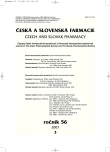Naphthoquinones and their pharmacological properties
Authors:
P. Babula 1; V. Adam 2; L. Havel 3; R. Kizek 2
Authors‘ workplace:
Veterinární a farmaceutická univerzita Brno, Farmaceutická fakulta, Ústav přírodních léčiv
1; Mendlova lesnická a zemědělská univerzita Brno, Agronomická fakulta, Ústav chemie a biochemie
2; Mendlova lesnická a zemědělská univerzita Brno, Agronomická fakulta, Ústav biologie rostlin
3
Published in:
Čes. slov. Farm., 2007; 56, 114-120
Category:
Review Articles
Overview
Naphthoquinones are wide-spread phenolic compounds in nature. They are products of bacterial and fungal as well as high-plants secondary metabolism. Juglone, lawsone, and plumbagin are the most widespread compounds. Naphthoquinones display very significant pharmacological properties – they are cytotoxic, they have significant antibacterial, antifungal, antiviral, insecticidal, antiinflammatory, and antipyretic properties. Pharmacological effects to cardiovascular and reproductive systems have been demonstrated too. The mechanism of their effect is highly large and complex – they bind to DNA and inhibit the processes of replication, interact with numerous proteins (enzymes) and disturb cell and mitochondrial membranes, interfere with electrons of the respiratory chain on mitochondrial membranes. Plants with naphthoquinone content are widely used in China and the countries of South America, where they are applied to malignant and parasitic diseases treatment.
Key words:
plumbagin – juglone – lawsone – naphthoquinones – pharmacology
Labels
Pharmacy Clinical pharmacologyArticle was published in
Czech and Slovak Pharmacy

2007 Issue 3
Most read in this issue
- Naphthoquinones and their pharmacological properties
- Thermoplastic granulation as an alternative method for the preparation of hydrophiliclipophilic oral matrix tablets
- Chitosan in topical preparations
- Medicinal preparations in a manuscript of a fifteen-century Franciscan monk in Brno
